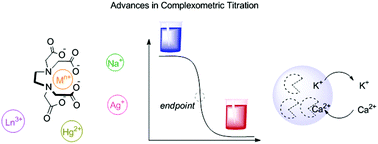Complexometric titrations: new reagents and concepts to overcome old limitations
Abstract
Chelators and end point indicators are the most important parts of complexometric titrations. The most widely used universal chelator ethylenediamine tetraacetic acid (EDTA) and its derivatives can strongly coordinate with different metal ions. Their limited selectivity often requires the use of masking agents, and the multiple pKa values of the chelators necessitate a careful adjustment of pH during the procedure. Real world requirements for pH independent, selective and sensitive chelators and indicators call for a new design of these reagents. New concepts and structures of chelators and indicators have indeed recently emerged. We present here recent developments on chelators and indicators for complexometric titrations. Many of these advances were made possible only recently by moving the titration from a homogeneous to a heterogeneous phase using a new class of chelators and indicators based on highly selective ionophores embedded in ion-selective nanosphere emulsions. In view of achieving titrations in situ by complete instrumental control, thin layer electrochemistry has recently been shown to be an attractive concept that replaces the traditional cumbersome titration protocol with a direct reagent free sensing tool.


 Please wait while we load your content...
Please wait while we load your content...